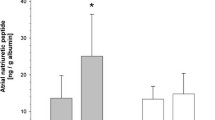Summary
ANP and c-GMP concentrations in 7 patients with chronic renal failure (CRF) undergoing regular hemofiltration (HF) were determined. After switching to hemodialysis (HD) under identical ultrafiltration and treatment time no significant difference of the ANP and c-GMP profiles was detected, suggesting that the type of treatment does not affect ANP and c-GMP plasma levels. In both procedures a continuous decrease of ANP and c-GMP was observed. Head down tilting to compensate hypotension during HD was immediately followed by an increase in ANP and c-GMP during ultrafiltration. An acute onset of tachyarrhythmia absoluta during HD was also accompanied by a rise in ANP plasma concentrations. This demonstrates that ANP secretion is not altered in patients with CRF. Since ANP plasma levels closely correlate with intravascular volume, periodic determination of this hormone in HD/HF patients may provide diagnostic information to detect volume overload.
Zusammenfassung
Bei 7 chronisch niereninsuffizienten Patienten, die regelmäßig hämofiltriert (HF) wurden, erfolgten während der Behandlung periodische Bestimmungen von ANP and c-GMP. Um den Einfluß des Blutreinigungsverfahrens auf die Veränderungen der Plasmakonzentrationen dieser Hormone zu untersuchen, wurde bei den Patienten eine Hämodialyse (HD) mit identischer Ultrafiltration und Behandlungsdauer durchgeführt. Bei beiden Behandlungsverfahren wurde ein gleichartiger kontinuierlicher Abfall von ANP und c-GMP beobachtet. Nach Kopf-Tieflagerung wegen Hypotonie unter HD stiegen die ANP und c-GMP Werte akut an. Bei einem anderen Patienten wurde gleichfalls ein akuter Anstieg während der HD beim Auftreten einer Tachyarrhythmia absoluta beobachtet. Diese Befunde zeigen, daß die Freisetzung von ANP bei chronischer Niereninsuffizienz nicht verändert ist. Da eine enge Beziehung zwischen Intravasalvolumen und der Höhe des Plasma ANP besteht, kann die regelmäßige Bestimmung dieses Hormons zur Beurteilung des Hydratationszustandes terminal niereninsuffizienter Patienten herangezogen werden.
Similar content being viewed by others
Literatur
Crozier JG, Nicholls MG, Ikram H, Espiner EA, Jandle TG, Jans S (1986) Atrial natriuretic peptide in humans. Production and clearance by various tissues. Hypertension 8 (Suppl II):11–15
Eisenhauer T, Talartschik J, Scheler F (1986) Detection of fluid overload by plasma concentration of human atrial natriuretic peptide (h-ANP) in patients with renal failure. Klin Wochenschr 64 (Suppl VI):68–72
Genest J (1986) The atrial natriuretic factor. Br Heart J 56(4):302–316
Gerzer R, Heim JM, Schütte B, Weil J (1987) Cellular mechanisms of action of atrial natriuretic factor. Klin Wochenschr 65 (Suppl VIII) 109–114
Laragh JH (1985) Atrial natriuretic hormone, the renin-aldosterone axis, and blood pressure-electrolyte homeostasis. N Engl J Med 313 (21):1330–1340
Maack T, Atlas SA, Camargo MJ, Cogan MG (1986) Renal hemodynamic and natriuretic effects of atrial natriuretic factor. Fed Proc 45:2128–2132
Kramer P, Matthei D, Arnold R, Ebert R, Köbberling D, McIntosh C, Schwinn E, Scheler F, Ludwig H, Reichel J, Spitella G (1977) Changes of plasma concentration and elimination of various hormones by haemofiltration. Proc EDTA, pp 144–150
Patterson WD, Hardman JG, Sutherland EW (1974) A comparison of cyclic nucleotide levels in plasma and cells of rat and human blood. Endocrinology 95:325–327
Rascher W, Bald M, Kröner F, Tulassy T, Müller-Wieffel DE (1988) Klinische Wertigkeit der Messung des atrialen natriuretischen Paptids im Plasma von Kindern mit chronischer Niereninsuffizienz. Z Kardiol 77 (Suppl 2) (Im Druck)
Rascher W, Tulassay T (1987) Hormonal regulation of water metabolism in children with nephrotic syndrome. Kidney Int (Suppl 21):83–89
Rascher W, Tulassay T, Lang RE (1985) Atrial natriuretic peptide in Plasma of volume-overloaded children with chronic renal failure. Lancet II:303–305
Saxenhofer H, Gnädinger MP, Weidmann P, Shaw S, Schohn D, Hess C, Uelinger DE, Jahn H (1987) Plasma levels and dialysance of atrial natriuretic peptide in terminal renal failure. Kidney Int 32:554–561
Sonnenberg H (1985) Atrial natriuretic factor — a new hormone affecting kidney function. Klin Wochenschr 63 (18):886–890
Talartschik J, Eisenhauer T, Voth E, Sold G, Scheler F (1988) Ist der Plasma-ANP-Spiegel ein Index für die Volumenexpansion bei Dialyse-Patienten? Z Kardiol 77 (Suppl 2) (Im Druck)
Author information
Authors and Affiliations
Rights and permissions
About this article
Cite this article
Eisenhauer, T., Talartschik, J., Quentin, E. et al. Beeinflussung von atrialem natriuretischen Peptid (ANP) und zyklischem GMP durch Hämofiltration und Hämodialyse. Klin Wochenschr 66, 940–945 (1988). https://doi.org/10.1007/BF01728958
Issue Date:
DOI: https://doi.org/10.1007/BF01728958




